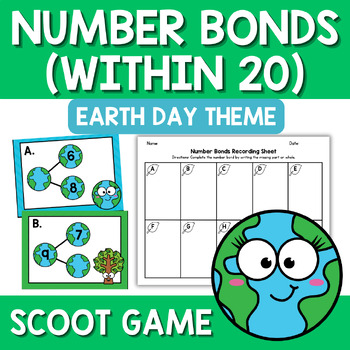Earth Day Number Bonds within 20 Fact Fluency Scoot Game Center Station 2nd Math
- PDF
Description
Earth Day Number Bonds Scoot Game for 2nd Grade Math Small Groups Centers/Stations (Addition & Subtraction Fact Fluency within 20)
Join the Earth Day festivities while strengthening number bond skills with our Earth Day Number Bonds Scoot Game, designed for 2nd-grade students. This eco-conscious resource features 20 Earth Day-themed cards, each displaying a number bond. Students will need to find either the missing part or whole, fostering mathematical fluency and environmental awareness.
Key Features:
- 20 Earth Day-themed number bond cards
- Engaging "Scoot" movement for interactive and environmentally conscious number bond practice
- Recording sheet for student progress tracking
- Versatile usage: whole group, small group, Earth Day number bond center/station
- Answer key for quick and easy grading
How to Play: Distribute the 20 Earth Day-themed number bond cards around the room. As students move from card to card, they'll encounter various number bonds. Task them with finding either the missing part or whole to complete the number bond. When you call out "scoot," students eagerly progress to the next task card, immersing themselves in an interactive Earth Day-themed exploration of number bonds.
Recording Sheet Included: Each student can monitor their progress using the provided recording sheet, facilitating seamless assessment and offering a valuable tool for personalized feedback. The recording sheet allows both students and teachers to track understanding effectively.
Versatile Usage: Integrate this game into whole group activities, small group interventions, or math centers/stations, providing flexibility to suit diverse classroom dynamics. The Earth Day theme infuses a sense of environmental consciousness and appreciation into the learning process.
Answer Key for Effortless Grading: Simplify grading with the included answer key, allowing teachers to focus more on facilitating engaging learning experiences and less on administrative tasks.
Celebrate Earth Day while reinforcing number bond skills with our Earth Day Number Bonds Scoot Game. Download now and watch your 2nd-grade students connect with nature as they deepen their understanding of number bonds!





